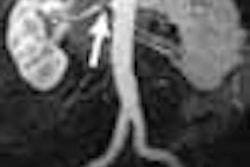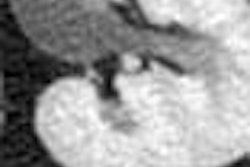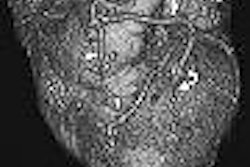SAN FRANCISCO - Although conspicuous consumption is the norm in modern society, when it comes to CT scanners, quality is vastly superior to quantity. The goal of a successful CT department should be to acquire more scans, not more scanners, through proper workflow management, according to a presentation at the International Symposium on Multidetector-Row CT, sponsored by Stanford University of Stanford, CA.
"Over the last 10 years or so, we have attempted to industrialize the practice of CT. What I'd like to discuss here is what we've done with respect to image acquisition," said Dr. Sanjay Saini in a talk on Thursday. "The take-home message here is that if you focus on optimizing the use of technology, the end result is that it will be good for patients, it'll be good for hospitals, it'll be good for radiologists, and it'll be good for industry."
Saini is the director of CT services at Massachusetts General Hospital (MGH) and a professor of radiology at Harvard Medical School, both in Boston.
Based on a 2000-2001 survey by the Food and Drug Administration, there were 60 million CT exams performed in the U.S. At MGH, the CT department performs about 120,000 CT exams every year (more than one exam per patient) so that in the 2004 fiscal year, they expect to hit about 130,000 exams, Saini said.
"We are growing at about 15,000 CT exams every year. Typically, a CT scanner does about 10,000 exams (annually). The challenge that we face in managing the growth of CT is that we need a new scanner a year," he said.
But that's easier said than done when physical space to house scanners is at a huge premium; staffing needs are not being met; and many facilities are reluctant to open up the checkbook for new expenses. Saini laid out some basic steps to keep a CT department running smoothly at maximum capacity.
Automation
First, Saini recommended a Web-based electronic ordering system to improve efficiency, particularly in an increasingly complex medical environment. The exam ordering form should include appropriate history and symptoms, as well as the indication for the exam, which is important for billing.
In addition, useful information can be sorted out beforehand, such as whether the patient requires a creatinine study or has an iodine allergy, as well as if contrast will be used for this particular exam.
The system also should link to a standardized image acquisition protocol; in this case, set out beforehand by the CT staff at MGH.
"All image acquisition parameters are uniform," Saini said. "The use of contrast material, the volume, the injection rate, the delays, they are all standardized. When delayed scans should be obtained, when an exam should be repeated, this is all predetermined. What constitutes an important allergy? Who needs allergy treatment? What is the treatment regimen? Who should get a renal function test? These are not questions that people should ask when a patient arrives. These are questions that have already been deliberated and determined, and there is a ready answer for all of them."
Finally, a standardized check box contrast reaction form should be used when necessary, rather than relying on a generic hospital incident report. Eventually, this type of information should be available from a RIS, Saini said.
Idle techs, not scanners
A good CT workflow strategy will be technologist-centered, Saini pointed out. Downtime for technologists is preferable to downtime for expensive machines. In the long run, overstaffing costs can be offset by having more people to do more exams and generating more income, he said.
"Get the physicians out of the way and put the technologists in charge," he emphasized. "By having a technologist-centered environment, what you are able to do is focus on room turnaround time."
At MGH, the RTs administer and monitor all the injections, QA/QC all the images, decide if any delayed images need to be obtained, and discharge all the patients.
"Very rarely do they actually call us to ask if there are any additional studies that need to be done," Saini said.
Training and education is critical to letting the technologists take over in areas that were traditionally manned by physicians. At MGH, one-hour mini-lectures are held on a daily basis. These talks cover issues such as delayed scans, image quality, or how a dual-head injector works. These sessions also reinforce the standardized CT protocols already in place.
CT rooms strictly for CT
Another key is to focus on room turnaround time. In theory, one patient can be scanned every 15 minutes. However, "if you think about it, it's a fairly silly way to look at things. We know that it takes 20 seconds to do the exam and it takes 14 1/2 minutes to do everything else," Saini pointed out.
When patients arrive they should head to a centralized check-in, where the health screening questionnaire can be administered. At this time patients can change clothes.
All of the patient preparation should be done outside of the CT room, including allergy discussion or starting intravenous lines.
"We don't use the CT table as an IV prep table," Saini said.
CT by numbers at MGH
To illustrate the importance of keeping up with department statistics, Saini shared the results of how this strategy at MGH affected his department as of June 19, 2004.
In 1996, the facility had four scanners; it now has 10 distributed as follows:
- Four scanners in the main department (two four-slice; two 16-slice)
- Two in the emergency department (one 16-slice; one four-slice)
- Two at off-campus imaging centers (one 16-slice; one eight-slice)
- One16-slice PET/CT
- One portable CT
But Saini pointed out that "the workhorse (scanners) are fewer. One is a research scanner, one is portable, and one is dedicated to interventional CT. Our workhorses are only six CTs, in comparison to 1996 when we had four CTs that were doing most of the work."
At MGH, 36% of the patients were referred for gastrointestinal exams, with 49% of the CT exams done in the abdomen and pelvis (fiscal year 2003-2004). A little more than half (56%) were done on an outpatient basis. The CPT codes most commonly used were CT of the pelvis and/or abdomen with contrast.
The week ending June 19, MGH did 2,600 CT exams, Saini said. The majority were done at the main hospital. On a typical weekday, 400-500 exams were done; up to 350 were done on weekends. These weekly reports also were broken down by day, scanner, and facility.
"The reason (these numbers) are important is because at the beginning of the year, we sit down with hospital administration and decide what we need to meet in terms of CT budget numbers," Saini explained. For fiscal year 2004, the target for CT was 1,770 exams on a single day. As of June 19, the department was doing 2,017 exams daily.
"As you can see, we beat that (target) considerably," he said. "What this allows the CT manager to do is adjust down the budgetary requirements for the remainder of the year."
The department also keeps track of patient metrics, such as wait times. Again, during the week ending June 19, the in-patient waiting time for a CT scan at MGH was 12 hours. The maximum in-patient wait was over a day while the minimum was a few minutes.
"On average, 95% of in-patient CT studies were done on the same day," Saini noted.
Less time, more money
If done correctly, CT can be the ideal high-tech, low-cost exam, Saini stated. Empowerment through training, standardization, and automation are the basic elements necessary to meet the "more scans, not scanners" mandate. And should funds become available for new equipment, a thriving CT department can make a case for itself.
"In our institution, dollars are not an issue because we are extremely budget-driven," Saini said. "If we can demonstrate that we can do a certain number of scans, then getting the dollars for technology isn't a problem. In fact, CT contributes a significant amount -- $25 million a year -- to the gross margin of our hospital."
Slashing unit costs will become a bigger issue as inflated CT reimbursement costs start to come down, which Saini said he believes will happen sooner rather than later.
"By focusing on scanner productivity, you end up lowering unit costs," Saini concluded. "When you do that, the next frontier will be (replacing) plain-film radiography with CT."
By Shalmali PalAuntMinnie.com staff writer
June 28, 2004
Related Reading
CT, radiation, and risk: two views, June 24, 2004
Imaging industry continues healthy growth, May 10, 2004
Filmless orthopedic clinic yields patient, physician satisfaction, April 13, 2004
Copyright © 2004 AuntMinnie.com



















